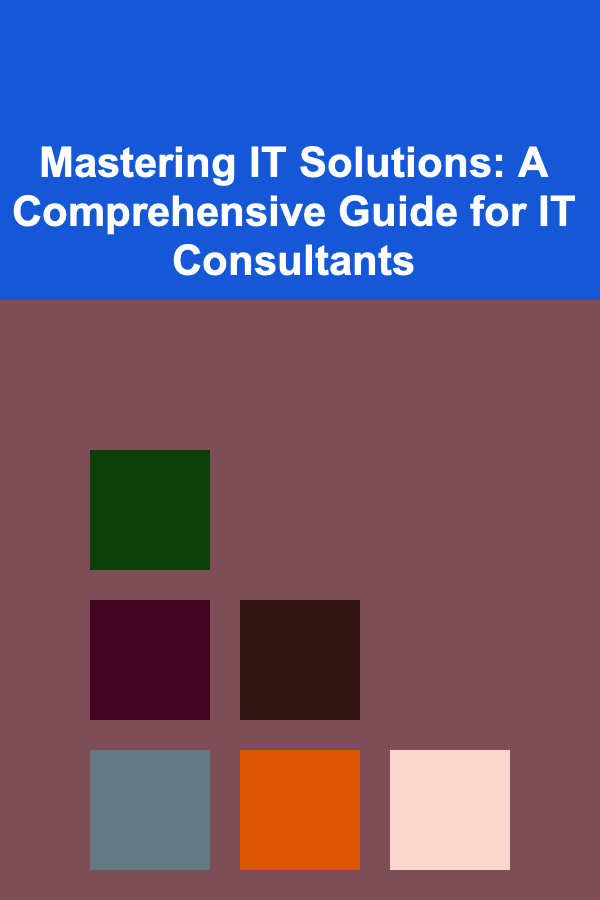
Mastering IT Solutions: A Comprehensive Guide for IT Consultants
ebook include PDF & Audio bundle (Micro Guide)
$12.99$5.99
Limited Time Offer! Order within the next:

The role of an IT consultant has evolved significantly over the years, with technology becoming central to the success of nearly every business. Whether you're working with startups, enterprises, or public sector organizations, understanding how to craft and implement effective IT solutions is critical for delivering long-term value.
This guide offers actionable insights and strategies for IT consultants looking to master the art of providing IT solutions that drive business success. From analyzing client needs to selecting the right technologies and managing complex implementations, this comprehensive guide covers the essential skills and best practices necessary for becoming an expert IT consultant.
Understanding Client Needs and Business Objectives
Before diving into technical solutions, it's paramount to understand the business context in which the technology will be applied. A consultant's primary responsibility is not just to solve technical problems, but to craft solutions that align with the client's broader business goals.
1. Conduct In-Depth Stakeholder Interviews
To properly assess client needs, you'll need to engage in meaningful conversations with key stakeholders across the organization. These individuals can provide insight into the company's goals, challenges, pain points, and future plans.
- Actionable Tip: Set up interviews with a range of stakeholders, including C-suite executives, managers, and end-users. Don't just talk to the IT department; gather input from sales, marketing, finance, and operations teams to fully understand how IT intersects with business processes.
- Example: If a client is looking to streamline its customer service, engaging with frontline employees and managers will help identify gaps in the current system and inform the design of a solution that boosts productivity and improves user satisfaction.
2. Align IT Solutions with Business Goals
Every IT recommendation you make must be directly aligned with the business's long-term objectives. For example, a client looking to reduce operational costs will need solutions that automate manual tasks, enhance efficiency, and offer scalability.
- Actionable Tip: Map technology solutions to specific business outcomes such as increased revenue, reduced overhead, or improved customer experience. Use frameworks like SMART (Specific, Measurable, Achievable, Relevant, Time-bound) goals to ensure that the IT solution meets clear business objectives.
3. Perform a Thorough IT Systems Audit
A comprehensive audit of the client's current IT infrastructure will help identify both strengths and weaknesses. This gives you insight into what works, what doesn't, and where technology upgrades or replacements are necessary.
- Actionable Tip: Use a framework like the ITIL (Information Technology Infrastructure Library) to assess the performance of existing systems and identify areas of improvement. Focus on network security, hardware performance, software compatibility, and data management practices.
Crafting IT Solutions
Once you've gained a deep understanding of your client's needs, the next step is to craft the right IT solutions. This involves selecting technologies that can address the identified challenges while ensuring scalability and alignment with the business's future growth.
1. Selecting the Right Technology Stack
Choosing the right technology stack is essential for building solutions that are both effective and sustainable. This decision can affect everything from system performance to maintenance and future scalability.
- Actionable Tip: Evaluate the full technology ecosystem, including hardware, software, cloud services, and third-party integrations. Consider factors such as cost, scalability, support, and integration capabilities when making decisions. Technologies like cloud computing (AWS, Azure), AI, machine learning, and DevOps can be game-changers, but the technology should match the client's needs and existing systems.
- Example: A client wanting to expand globally might benefit from a cloud-based solution that offers scalability, remote accessibility, and robust disaster recovery capabilities. In this case, a hybrid cloud solution integrating with existing on-premise systems could be the best fit.
2. Building Scalable, Future-Proof Solutions
One of the greatest challenges in technology consulting is recommending solutions that are not only effective today but also adaptable to future needs. Businesses evolve, and IT systems must grow with them.
- Actionable Tip: Focus on solutions that are modular and can scale as the business grows. Adopt microservices architectures, which allow components of the system to be developed, deployed, and scaled independently. This way, future upgrades can be implemented without overhauling the entire infrastructure.
- Example: A company transitioning from an on-premise ERP solution to a cloud-based system may need a phased approach to ensure minimal disruption. By migrating departments gradually and integrating a cloud platform with the existing systems, the company can ensure smooth scaling as business demands grow.
3. Prioritize Cybersecurity and Compliance
In today's digital-first world, cybersecurity and regulatory compliance are non-negotiable. No matter how efficient your solution is, if it isn't secure, it's not viable.
- Actionable Tip: Incorporate security best practices from the very beginning. Use encryption, secure authentication methods, and compliance frameworks (such as GDPR, HIPAA, or PCI DSS) to ensure that your solutions meet industry standards. Regular security audits and vulnerability testing should also be part of the implementation process.
- Example: If you're designing a customer portal, ensure that the solution adheres to best practices in data protection. Implement secure authentication methods (like two-factor authentication), use encryption for data storage and transmission, and ensure that the system complies with relevant data protection regulations.
Implementing IT Solutions
Creating the right technology solution is just one part of the equation; implementation is where the real challenges arise. Successful implementation requires careful planning, stakeholder buy-in, and a strong focus on minimizing disruption to ongoing business activities.
1. Develop a Robust Implementation Plan
A successful implementation plan should outline every step of the process, from project kickoff to post-implementation support. This includes timelines, resource allocation, risk assessments, and a detailed communication plan.
- Actionable Tip: Use project management methodologies such as Agile or Scrum to ensure that the implementation process is iterative and flexible. Break the project down into phases, with clear milestones to track progress.
- Example: When implementing an enterprise resource planning (ERP) system, it's essential to create a phased rollout plan. Start by migrating core business functions and then gradually transition other departments over time. This approach reduces risk and ensures a smoother transition.
2. Manage Change Effectively
Introducing new technology can be disruptive, and one of the most common reasons for project failure is poor change management. Your clients must be prepared for the cultural shift that comes with new IT systems.
- Actionable Tip: Develop a change management strategy that includes communication, training, and support. Identify internal champions who can advocate for the new system, provide on-the-ground support, and help others through the transition.
- Example: If you're rolling out a new CRM system, ensure that end-users receive adequate training. Conduct workshops, create user guides, and offer a support hotline for employees during the transition. This will increase adoption and reduce resistance to change.
3. Monitor and Optimize Post-Implementation
After implementation, it's essential to monitor the performance of the solution and ensure it continues to meet the business's needs. Regular feedback loops and system optimization are crucial for ongoing success.
- Actionable Tip: Use monitoring tools and analytics to track system performance. Schedule regular check-ins with clients to evaluate whether the solution is delivering the expected outcomes. Collect feedback from users and identify areas for further improvement or optimization.
- Example: A newly implemented e-commerce platform should be monitored for uptime, speed, and user engagement. If customers are dropping off at a particular point in the checkout process, further refinement and optimization may be necessary.
Building Lasting Client Relationships
To truly master IT consulting, you must go beyond delivering successful projects. Building long-term relationships with your clients ensures repeat business and establishes you as a trusted advisor.
1. Focus on Long-Term Value
Always aim to add value beyond the immediate project. Help your clients stay ahead of the curve by offering insights into emerging technologies and suggesting strategies for continuous improvement.
- Actionable Tip: Regularly review your clients' IT strategies and offer proactive recommendations. For instance, if new cybersecurity threats emerge, reach out with advice on how they can bolster their defenses or stay compliant with new regulations.
- Example: If a client is expanding into a new market, you could suggest new technologies or operational strategies that could help them scale efficiently and safely.
2. Provide Ongoing Support and Maintenance
Technology needs evolve, and so do business requirements. Offering ongoing support services ensures your clients' IT systems remain optimized and capable of meeting their changing needs.
- Actionable Tip: Offer managed services or support contracts that include regular system updates, performance monitoring, and emergency troubleshooting. This ensures a steady income stream for your business while providing clients with peace of mind.
- Example: For a client using a cloud-based data storage solution, provide them with ongoing security monitoring and quarterly reviews to ensure the solution continues to meet their needs as the business grows.
Conclusion
Mastering IT solutions as an IT consultant requires a combination of technical expertise, business acumen, and strategic thinking. By understanding the client's needs, selecting the right technologies, and implementing solutions effectively, consultants can create lasting value that drives business success. Whether it's managing complex IT transformations, ensuring security, or offering ongoing support, the role of the IT consultant is integral to helping businesses thrive in an increasingly digital world. Stay agile, continually refine your skills, and always focus on delivering solutions that solve real business problems.

How to Develop Your Sense of Rhythm in Prose
Read More
How to Make Your Home More Soundproof with Simple Upgrades
Read More
How to Save Money on Utilities and Lower Your Monthly Bills
Read More
How To Utilize Chatbots for Small Business Customer Service
Read More
How to Protect Your Assets
Read MoreOther Products

How to Develop Your Sense of Rhythm in Prose
Read More
How to Make Your Home More Soundproof with Simple Upgrades
Read More
How to Save Money on Utilities and Lower Your Monthly Bills
Read More
How To Utilize Chatbots for Small Business Customer Service
Read More